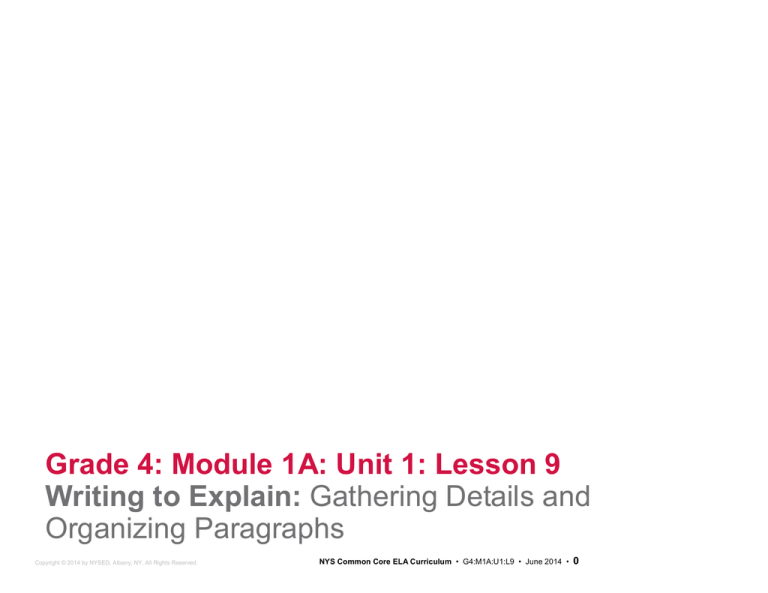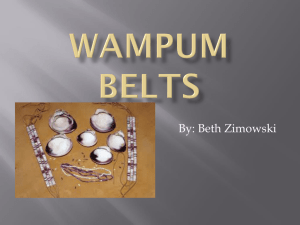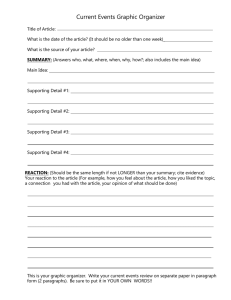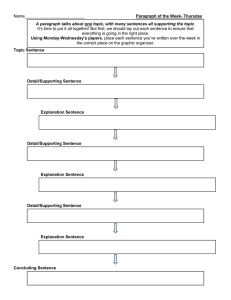
Grade 4: Module 1A: Unit 1: Lesson 9 Writing to Explain: Gathering Details and Organizing Paragraphs
Copyright © 2014 by NYSED, Albany, NY. All Rights Reserved. NYS Common Core ELA Curriculum • G4:M1A:U1:L9 • June 2014 • 0 GRADE 4: MODULE 1A: UNIT 1: LESSON 9 Writing to Explain: Gathering Details and Organizing Paragraphs Long­Term Targets Addressed (Based on NYSP12 ELA CCLS) I can choose evidence from fourth­grade literary or informational texts to support analysis, reflection, and research. (W.4.9) I can use the writing process to produce clear and coherent writing (with support). (W.4.5) I can produce complete sentences. (L.4.1f) I can engage effectively in a collaborative discussion. (SL.4.1) Supporting Learning Targets Ongoing Assessment • I can explain how the symbols on my wampum belt connect to the texts I have read. • Personal Wampum Belt: Four­Square graphic organizer • I can reread to find specific details. • I can plan a paragraph explaining my wampum belt. Agenda Teaching Notes 1. Opening • In advance: Be prepared to model a paragraph about the wampum belt you created. Connect your belt to the ideas in the poem “A Time to Talk” or the text “Two Row Wampum”. A. Engaging the Writer (10 minutes) 2. Work Time A. Complete Sentences mini­lesson (20 minutes) B. Modeling: Gathering Details and Using a Four­Square Graphic Organizer to Plan a Paragraph (15 minutes) • In advance: Create Next Steps for Planning Your Paragraph anchor chart. See Work Time A for guidance about what to put on this new chart. • This lesson begins the first of a series of writing lessons in this module. Emphasize to students that writing is more than just organizing their ideas or editing for conventions. In order to write well about something, you need to know a lot about it. Students have been building that knowledge for the past week, and will keep revisiting that knowledge as they write.
C. Planning a Paragraph (15 minutes) 3. Closing and Assessment A. Share and Debrief (5 minutes) 4. Homework Copyright © 2014 by NYSED, Albany, NY. All Rights Reserved. NYS Common Core ELA Curriculum • G4:M1A:U1:L9 • June 2014 • 1 GRADE 4: MODULE 1A: UNIT 1: LESSON 9 Writing to Explain: Gathering Details and Organizing Paragraphs Lesson Vocabulary Materials symbol, complete, sentence, subject, run­on, fragment, noun, verb, paragraph, topic sentence, details • Complete Sentences worksheet (see Supplemental Materials) • Student­created wampum belts (from Lesson 8) • Keeping Track of How It All Fits Together anchor chart (begun in Lesson 2) • Making Connections anchor chart (from Lesson 5) • Exit paragraph (from Lesson 5) • Two Row Wampum story (Lesson 6) for teacher modeling • A Time to Talk (Lesson 7) for teacher modeling • Thanksgiving Address (Lesson 1) • “Birth of the Haudenosaunee” (Lesson 3) • Wampum Belt: Four­Square Graphic Organizer (see Supplemental Materials, one per student) Opening Meeting Students’ Needs A. Opening: Engaging the Reader (5 minutes) • Lead a brief class discussion about the purpose of wampum in the Haudenosaunee culture as well as what the purpose is of the images on the belts. Remind students of the wampum belt they created in the previous lesson. They should have created a belt that connects to an idea in Thanksgiving Address and “Birth of the Haudenosaunee”. • Talk with students about the learning targets for the day: • “I can explain how the symbols on my wampum belt connect to the texts I have read.” • “I can reread to find specific details.” • “I can plan a paragraph explaining my wampum belt.” • Explain that they will be writing a paragraph about their wampum belt for the end of the unit assessment. Today they will begin the planning for that paragraph. • Remind students that in order to write well, they need to have a solid understanding of what they are writing about. They have been studying the ideas of the Haudenosaunee for over a week. As they get ready to write their paragraphs, they will keep going back into their reading, their notes, and their wampum belt in order to keep developing their knowledge and understanding.
Copyright © 2014 by NYSED, Albany, NY. All Rights Reserved. NYS Common Core ELA Curriculum • G4:M1A:U1:L9 • June 2014 • 2 GRADE 4: MODULE 1A: UNIT 1: LESSON 9 Writing to Explain: Gathering Details and Organizing Paragraphs Work Time Meeting Students’ Needs A. Complete Sentences Mini­Lesson (20 minutes) • If students are unfamiliar with nouns and verbs, build time into the day to teach these parts of speech. • Explain to students that in order to write well, they have to be able to convey ideas clearly. One way to do this is to ensure that the sentences in their paragraphs are complete sentences. Write the words “complete sentence” on the board. Ask students if they know what this means. Cold call students who volunteer. If students are unsure, have them define the word “complete”. Listen for “having all the required parts”. Explain to students that a sentence can be a word (Help!) or a group of words that must contain a subject (doer), a verb (action), and a complete thought. • Modeling provides a clear vision of the expectation for students. .
• Display this sentence for all students to see: Miguel cleaned his room. Say: “The subject in this sentence is Miguel. He is the one doing something. (circle Miguel) What did he do? He cleaned. (underline cleaned) That is the verb, or the action word. The words together make a complete thought. When you can identify the subject (or the one who is doing), and the verb (or the action), and a complete thought is conveyed, you have a sentence.” • Say, “Sometimes in our reading or writing, we will see part of a sentence, or a fragment. A fragment is a group of words that might lack a subject or a verb and does not make a complete thought.” Display these sentences for students to see and continue to model circling the subject and underlining the verb: • While in class. Explain that this sentence has no subject or verb and does not convey a complete thought. • Dogs chasing cars. This sentence has a subject (dogs) and a verb (chasing), but does not convey a complete thought. • Playing in the park. This sentence has a verb (playing) and possibly a subject (park) but does not convey a complete thought. • Model how to correct these three sentences, explaining what the subject and verb are for each one. • Say, “On one hand we have sentence fragments. On the other, we have run­on sentences.” Ask students if they know what a run­ on sentence is or if they can guess what it may be. Listen for or explain, “A run­on sentence is two (or more) sentences incorrectly written as a single sentence.” Display these sentences for students to see and continue to model circling the subject and underlining the verb: • I love my teddy bear, he’s so soft. Explain that this sentence is actually two sentences separated by a comma. • My sister’s party is going to be fun at the skating rink with her friends. Explain that this sentence is three ideas combined into one sentence. • Model how to correct these two sentences, explaining what the subject and verb are for each one. • Distribute Complete Sentences handout found in Supplemental Materials. In pairs, students will complete the worksheet which will be reviewed as a whole class. Review the directions and clarify as needed. Copyright © 2014 by NYSED, Albany, NY. All Rights Reserved. NYS Common Core ELA Curriculum • G4:M1A:U1:L9 • June 2014 • 3 GRADE 4: MODULE 1A: UNIT 1: LESSON 9 Writing to Explain: Gathering Details and Organizing Paragraphs • Circulate to provide support as students complete the worksheet. • Review the sheet as a whole class calling on volunteers to share their revised sentences. • Tell students that they should keep this lesson in mind when writing their paragraphs. Emphasize the importance of conveying a complete thought in each sentence. • This topic will be revisited in the next unit. Work Time Meeting Students’ Needs B. Modeling: Gathering Details and Using a Four­Square Graphic Organizer to Plan a Paragraph (15 minutes) • Explain to students that the paragraph they will begin planning today will focus on how the wampum belt they created connects to ideas found in the Thanksgiving Address and “Birth of the Haudenosaunee”. This means they will need to use evidence from the texts in order to write this paragraph. • For students needing additional support, consider modifying the graphic organizer. Some changes you might make are to provide key words in a word bank and/or a sentence frame for the concluding sentence.
• Introduce the Four­Square graphic organizer on your document camera or on a chart as the method students will use to plan their paragraphs. Show students how the center rectangle has space for the topic sentence of a paragraph, then the boxes for supporting details, then the box for the conclusion. Discuss the meaning of topic sentence, supporting details, and conclusion as needed. • Tell students that they are going to help you work on your own paragraph for your wampum belt. • Remind students of the wampum belt you created and showed them yesterday. Recall what the wampum belt depicts and that it connects to the ideas in the poem “A Time to Talk”. Explain that you are going to model how to fill out this graphic organizer and they are going to help you. Ask students to Think­Pair­Share about the first sentence in the paragraph. Tell them it should let the reader know what the paragraph is about. Accept suggestions from students and/or revise their suggestions until you have something such as: “My wampum belt connects to the idea of communication in the poem ‘A time to Talk’.” Write this sentence in the Topic Sentence box. • Direct students’ attention to the upper left­hand box. Write down one of your symbols and model your thinking to fill in how it connects to the poem in that box. • Explain that we now need details to support the connection between the wampum belt and the poem. Model looking at the Supporting Details column of your anchor chart to select details that are appropriate. If necessary, model returning to the texts to find details. Point out the difference between adding details to your graphic organizer and copying whole sentences. • Say, “Now I will add another symbol to the box on the right­hand side.” Model writing supporting details in the top right­hand box. Copyright © 2014 by NYSED, Albany, NY. All Rights Reserved. NYS Common Core ELA Curriculum • G4:M1A:U1:L9 • June 2014 • 4 GRADE 4: MODULE 1A: UNIT 1: LESSON 9 Writing to Explain: Gathering Details and Organizing Paragraphs • Do the same for the bottom left­hand box. • Inform students that we will work on the conclusion in the next lesson. • Post the new Next Steps for Planning Your Paragraph anchor chart to guide students during their work period: • Write a topic sentence. • Collect details from the original texts and your anchor charts to complete your graphic organizer. • Reread the text/s you are writing about to collect specific details. C. Planning a Paragraph (15 minutes) • Remind students that today is mostly about starting to gather information that might help them focus their writing. They will have plenty of time to actually write their paragraph in the next lesson. • Distribute Wampum Belt: Four­Square Graphic Organizer. Ask students to begin filling in their Four­Square graphic organizer for their own wampum belt, beginning with the topic sentence. Remind them that they may use their Keeping Track and Making Connections anchor charts as well as the paragraph they wrote in Lesson 5. • Circulate to support as needed. • Students may need additional modelling and support for this activity. Consider providing partially filled­in graphic organizers and/or providing more class time for the completion of this graphic organizer. Closing and Assessment Meeting Students’ Needs A. Share and Debrief(5 minutes) • Ask students to quickly form groups of four (ideally at their desks/tables). Invite students to share out with their group the idea/s they selected to write about. • Developing self­assessment and reflection supports all learners.
• Ask students to give a thumbs­up/thumbs­sideways/thumbs­down to show how far they have gotten with the graphic organizer. • Ask students to think about the learning targets from today. How are rereading, talking, and using the Four­Square graphic organizer helping them to plan their paragraphs for their postcards? Can students predict what they are going to do next? Copyright © 2014 by NYSED, Albany, NY. All Rights Reserved. NYS Common Core ELA Curriculum • G4:M1A:U1:L9 • June 2014 • 5 GRADE 4: MODULE 1A: UNIT 1: LESSON 9 Writing to Explain: Gathering Details and Organizing Paragraphs Homework Meeting Students’ Needs Note: Collect graphic organizers. Provide feedback before the next lesson. Students will use this feedback to help revise and/or complete their graphic organizers next class and begin their paragraphs. For each student, first mention a strength in terms of the content students included: How does it reflect their knowledge or understanding they have built during the past week? Then give each student specific feedback. For example, you might say: “You did a great job selecting details from the “Birth of the Haudenosaunee”. Those are all things we read and talked about. I noticed that you haven’t yet chosen a second detail to support your connection. Please include one more thing and some specific details from our reading. You may need to reread some of the texts we read this past week to help you find more details.”
Copyright © 2014 by NYSED, Albany, NY. All Rights Reserved. NYS Common Core ELA Curriculum • G4:M1A:U1:L9 • June 2014 • 6 GRADE 4: MODULE 1A: UNIT 1: LESSON 9 Wampum Belt: Four Square Graphic Organizer SUPPLEMENTAL MATERIALS GRADE 4: MODULE 1A: UNIT 1: LESSON 9 Grade 4: Module 1A: Unit 2: Lesson 9 Supplemental Materials
Grade 4: Module 1: Unit 1: Lesson 9 Supporting Materials This work is licensed under a Creative Commons Attribution­NonCommercial­ShareAlike 3.0 Unported License. Exempt third­party content is indicated by the footer: © (name of copyright holder). Used by permission and not subject to Creative Commons license. Copyright © 2014 by NYSED, Albany, NY. All Rights Reserved. NYS Common Core ELA Curriculum • G4:M1A:U1:L9 • June 2014 • 7 GRADE 4: MODULE 1A: UNIT 1: LESSON 9 Directions: Read each group of words. Identify whether it is a run­on (r), fragment (f), or sentence (s). Correct the run­ons and fragments to make them complete sentences. 1. _____ Beads from clams. 2. _____ Wampum belts have many uses. 3. _____ Wampum belts have symbols, the patterns in the belts tell about treaties, nations and wars. 4. _____ Three principles to make this treaty last. 5. _____ First, he took a single arrow and broke it in half, then he took five arrows and tied them together. 6. _____ Recorded this agreement on paper. 7. _____ The Haudenosaunee see this as a living treaty. 8._____ In 1613, the Mohawks. 9._____ The Tree of Peace, which symbolizes the Great Law of Peace. 10._____ Haudenosaunee communities continue to live by the principles of the Great Law. 11._____ All council members must agree on the issue this is called consensus. 12._____ The Haudenosaunee open and close every social and religious meeting with the Thanksgiving Address, it is also said as a daily sunrise prayer.
Copyright © 2014 by NYSED, Albany, NY. All Rights Reserved. NYS Common Core ELA Curriculum • G4:M1A:U1:L9 • June 2014 • 8 GRADE 4: MODULE 1A: UNIT 1: LESSON 9 Wampum Belt: Four­Square Graphic Organizer (For teacher reference) First symbol on your wampum belt: Second symbol on your wampum belt: Details (Describe the symbol. What does it symbolize? How does it connect to A Time to Talk? Details (Describe the symbol. What does it symbolize? How does it connect to A Time to Talk?) Topic Sentence:
Third symbol on your wampum belt: Details (Describe the symbol. What does it symbolize? How does it connect to A Time to Talk?) Conclusion (For more information about the Four­Square approach, see: Four­Square Writing Method: A Unique Approach to Teaching Basic Writing Skills, by E. J. Gould and J. S. Gould [Teaching and Learning Company, 1999]) Copyright © 2014 by NYSED, Albany, NY. All Rights Reserved. NYS Common Core ELA Curriculum • G4:M1A:U1:L9 • June 2014 • 9 GRADE 4: MODULE 1A: UNIT 1: LESSON 9 Wampum Belt: Four Square Graphic Organizer Name: Date: First symbol on your wampum belt: Second symbol on your wampum belt: Details (Describe the symbol. What does it symbolize? How does it connect to “Birth of the Haudenosaunee”? Details (Describe the symbol. What does it symbolize? How does it connect to the Thanksgiving Address?) Topic Sentence:
Third symbol on your wampum belt: Details (Describe the symbol. What does it symbolize? How does it connect to “Birth of the Haudenosaunee” or Thanksgiving Address?) Copyright © 2014 by NYSED, Albany, NY. All Rights Reserved. Conclusion NYS Common Core ELA Curriculum • G4:M1A:U1:L9 • June 2014 • 10




